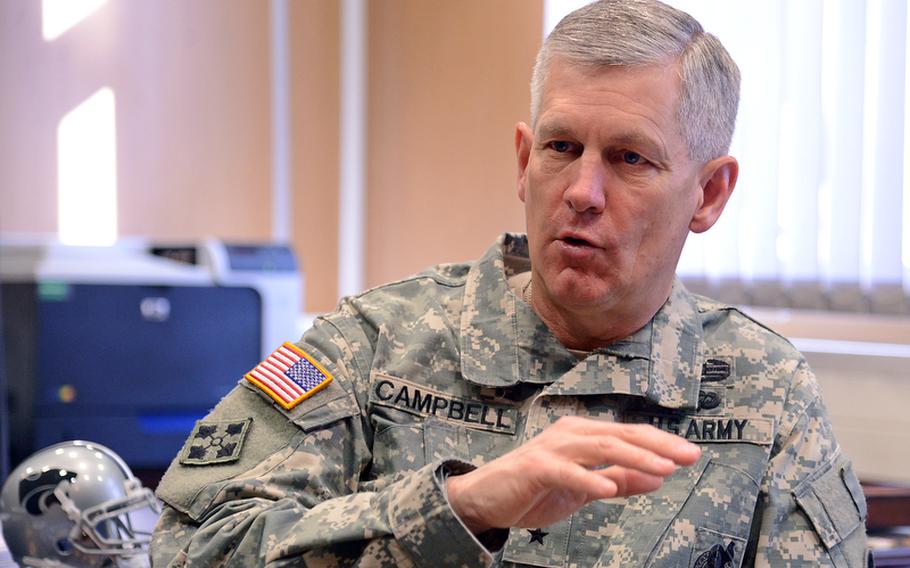
U. S. Army Europe commander Lt. Gen. Donald Campbell talked Monday about the effects sequestration will have on USAREUR. (Michael Abrams/Stars and Stripes)
WIESBADEN, Germany — Some American units in Europe could soon be unprepared to deploy as U.S. Army Europe grapples with a $166 million budget shortfall caused by the across-the-board spending cuts known as sequestration.
The command spent months planning to offset the anticipated sequester-related budget reduction, and was able to cover $286 million of the overall cuts of $452 million imposed on USAREUR.
The shortfall is small compared to the roughly $47 billion budget cut the Pentagon took with the sequestration order President Barack Obama signed Friday, but leaves the command with some hard decisions as it tries to close a budget gap and maintain support for soldiers.
The full effect of the deficit may not materialize — and isn’t likely to be clear — for months, USAREUR commander Lt. Gen. Donald M. Campbell said.
“Today, I feel pretty confident in sending just about any unit in USAREUR, with some additional training, pretty quickly to any contingency,” Campbell said in an interview Monday. “If you ask me that, would I feel that way in three to six months, I’d probably be a little more worried about our ability to do that.”
USAREUR’s annual budget typically runs between $1.2 billion and $1.3 billion, according to USAREUR officials. The command also gets between $300 million and $400 million a year to cover the cost of contingency operations, such as the recent deployment of U.S. forces with Patriot missile defense systems to guard Turkey from the threat of Syrian missiles, officials said.
Though most of the $452 million withdrawn from USAREUR came from its base budget, some came from its overseas contingency operations budget, leaving that account $16 million short, Campbell said.
“So we’ll need cash by probably the middle of April to be able to continue with a lot of those operations.”
Campbell said he was in discussions with the Army and U.S. European Command to provide those funds, but the decision will be made at levels above him.
The command will continue to look for other ways to close the $166 million hole, Campbell said, but he’s not optimistic it can be filled with further spending reductions by USAREUR.
“I think we’ve absorbed about all we’re going to be able to,” he said. “We literally will have to be funded with some part of the $166 million to be able to continue certain things here from a training and readiness standpoint.”
Under the command’s cost-cutting plan, units not in line for deployment will not conduct live-fire exercises above the platoon level, Campbell said.
While that won’t immediately erode units’ capabilities should they be needed to deploy on short notice, “my expectation is that you will be less ready and less trained over time.”
A handful of priorities will remain fully funded, though, even as most parts of the command’s budget continue to be scrutinized for cost savings.
Units preparing for deployment to Afghanistan or other operations will continue to train as they did before sequestration kicked in, Campbell said. USAREUR also plans to fully fund its NATO obligations.
The plan also protects professional development courses for which the Army selects personnel, such as the Advanced Leadership Course for noncommissioned officers and intermediate schools for officers.
While civilian pay is also protected, furloughs are still an option for USAREUR’s civilian workforce. The Pentagon has already alerted Congress that it may furlough civilians one day a week from late April through the end of the fiscal year — a move that would strip them of 22 paydays.
If the Pentagon moves forward with the plan, it won’t likely improve USAREUR’s fiscal outlook.
“That savings, I don’t get back because it goes right back to the department” of the Army, Campbell said. “So whatever savings I reap from the furlough, I’m not a benefactor.”
Officials involved in developing the command’s cost-cutting plan said USAREUR has very little discretionary spending.
“There’s just an awful lot of must-pays,” one official said speaking on background.
But they do have some leeway.
USAREUR’s plan also curtails support to all external ceremonies and air shows except for D-Day, for which support will be reduced. All temporary duty — or TDY — is cut by 50 percent and out-of-country TDYs require a general officer’s approval, while in-country TDYs require the signature of a colonel, senior executive schedule or general schedule-15 equivalent.
Supply requisitions are now limited to “must fund” only and funding for non-USAREUR unit training has been slashed altogether, according to a USAREUR official. The plan also reduces air and ground transportation operational tempos, occasionally grounding aircraft and idling trucks.
Out of 32 conferences USAREUR was scheduled to attend or host, just four will go forward as planned; the rest will be canceled or deferred. Saved are the Government Relations Symposium; the 21st Annual Conference of European Armies; the 6th Annual Conference of European Armies for NCOs; and the Outreach-Kontakt Training Conference.
Campbell said one conference canceled by his staff and instead conducted by video teleconference already saved the command $50,000 in TDY expenses.
Campbell warned that the outlook for his command could get even worse if leaders in Washington don’t come to an agreement on a budget for fiscal 2013. A continuing resolution under which the Pentagon and its subordinate commands have been operating expires March 27, turning off the money tap altogether.
Extending the continuing resolution “doesn’t really fix the problem,” Campbell said. “It just kicks the can down the road again.”
“We all clearly realize that these are challenging times, but I think the biggest piece to it is just the uncertainty — the uncertainty of where we’ll be in three to six months, six to nine or a year. Where will we be?”
millhamm.matt@stripes.com Twitter: @mattmillham